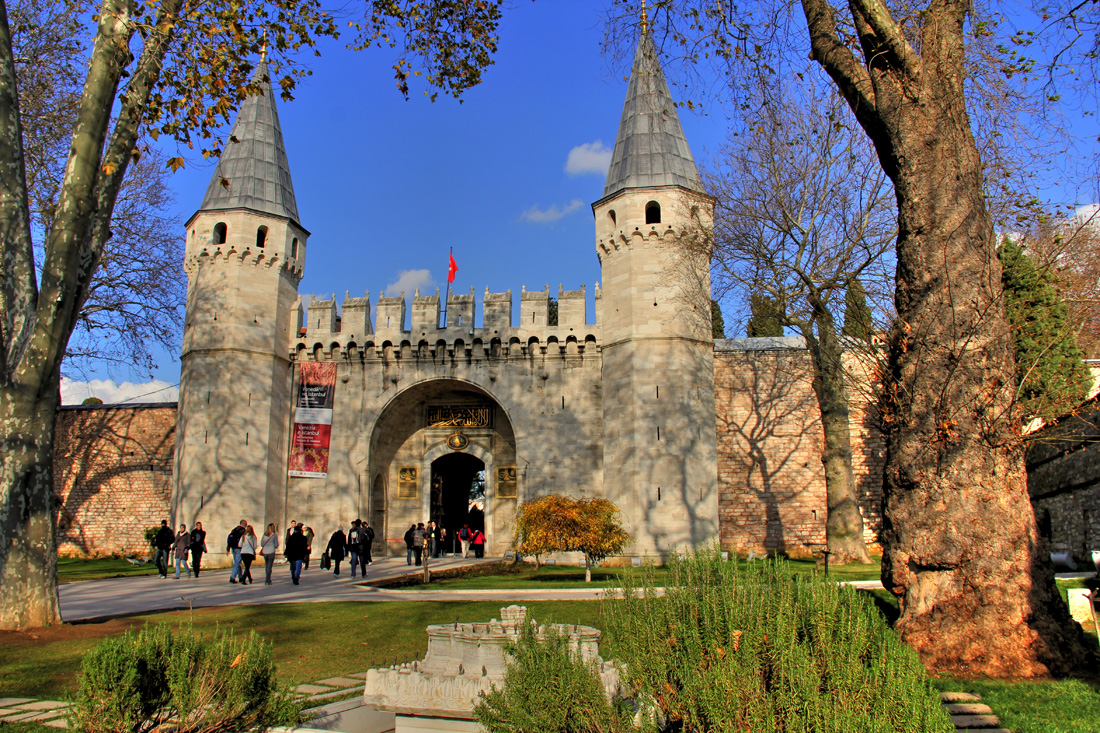Dolmabahçe Sarayı (1843-1856)
The breathtaking complex is one of the best structures decorating the magnificent silhouette of the Bosphorus in Istanbul. It is also an excellent example of how a palace should look. Everything in and around the palace is exquisitely detailed and stunning.
The word ‘Dolmabahçe’ means ‘filled-in garden’ in Turkish. The outer imperial garden (Hadaik-i Hassa), established here on land was reclaimed from the sea on the shore of the Bosphorus. The area, which was originally a bay, used by the navy, was turned into a garden during the reign of Ahmed I (1590, 1603-1617). Ahmed I built a seven-domed kiosk, called the Beşiktaş Palace. Almost two centuries after the short-lived Beşiktaş Palace, the area was chosen by the 31st Ottoman Sultan Abdülmecid (1823, 1839-1861) to build a major palace complex, as he planned to move the government and the residence from the Topkapi Palace, which had been the imperial residence for four centuries.
Sultan Abdülaziz (1861-1876), Sultan Abdülmecid’s brother, was the second sultan who lived in this palace. Sultan Abdulhamid II(1876-1909) abandoned the Dolmabahçe Palace and governed the Empire from the Yildiz Palace throughout his reign of 33 years.
 Until 1924, the palace hosted six Ottoman Sultans. Between 1927 and 1949, the palace was used as a presidential office and residence by the new republic. Mustafa Kemal Ataturk, the founder of the Turkish Republic, was the last person who lived here. Everything has been preserved since Ataturk’s passing away in 1938. The palace was used for official ceremonies until 1984. It became a museum in 1984.
Until 1924, the palace hosted six Ottoman Sultans. Between 1927 and 1949, the palace was used as a presidential office and residence by the new republic. Mustafa Kemal Ataturk, the founder of the Turkish Republic, was the last person who lived here. Everything has been preserved since Ataturk’s passing away in 1938. The palace was used for official ceremonies until 1984. It became a museum in 1984.
Unlike the authentic Ottoman lifestyle in the Topkapi Palace, the lifestyle of the sultan and his family in later centuries became European, reflected in the Dolmabahçe Palace.
The cost of the construction of the palace was very high. Construction started in 1843 by the architect Garabet Balyan (1800-1866) and was completed in 1856 by his son, Nigoğos Balyan (1826-1858). The Armenian Balyan Family were prominent late-Ottoman architects. The well-preserved structure is still in its original state.
The whole complex with 16 different sections covering the area of 110,000 m2 includes the mixed architectural styles of Baroque, Rococo, and Neo-classic, also reflecting the traditional Ottoman lifestyle. The three-floor structure including the basement has two main entrances on the landside and five gates on the seaside. The palace is famous with its symmetrical design and decoration.
The palace complex is composed of a walled inner palace along the waterfront and a group of auxiliary buildings just outside the palace walls. The Dolmabahce Palace Bosphorus shoreline measures 700 m long.
 The palace has many auxiliary buildings. One of them is the Camlı Köşk (Glass Pavilion). This pavilion with the street view over the wall was used by Sultans to watch military parades and their subjects. It functioned as the eye of the palace to observe the world outside. It was named after the green house next to it, which extensively uses glass from the most current glass technologies of that period. There is also a small Bird Gallery, built in 19th century for the birds of the Sultan.
The palace has many auxiliary buildings. One of them is the Camlı Köşk (Glass Pavilion). This pavilion with the street view over the wall was used by Sultans to watch military parades and their subjects. It functioned as the eye of the palace to observe the world outside. It was named after the green house next to it, which extensively uses glass from the most current glass technologies of that period. There is also a small Bird Gallery, built in 19th century for the birds of the Sultan.
The tourist entrance to the palace is near the ornate clock tower. You must take a guided tour to see the inside of the palace. The full tour of the palace takes two hours.
There is an outdoor café with premium a Bosphorus view, where one can have light snacks with tea or coffee.
Dolmabahçe Palace Museum Complex includes;










